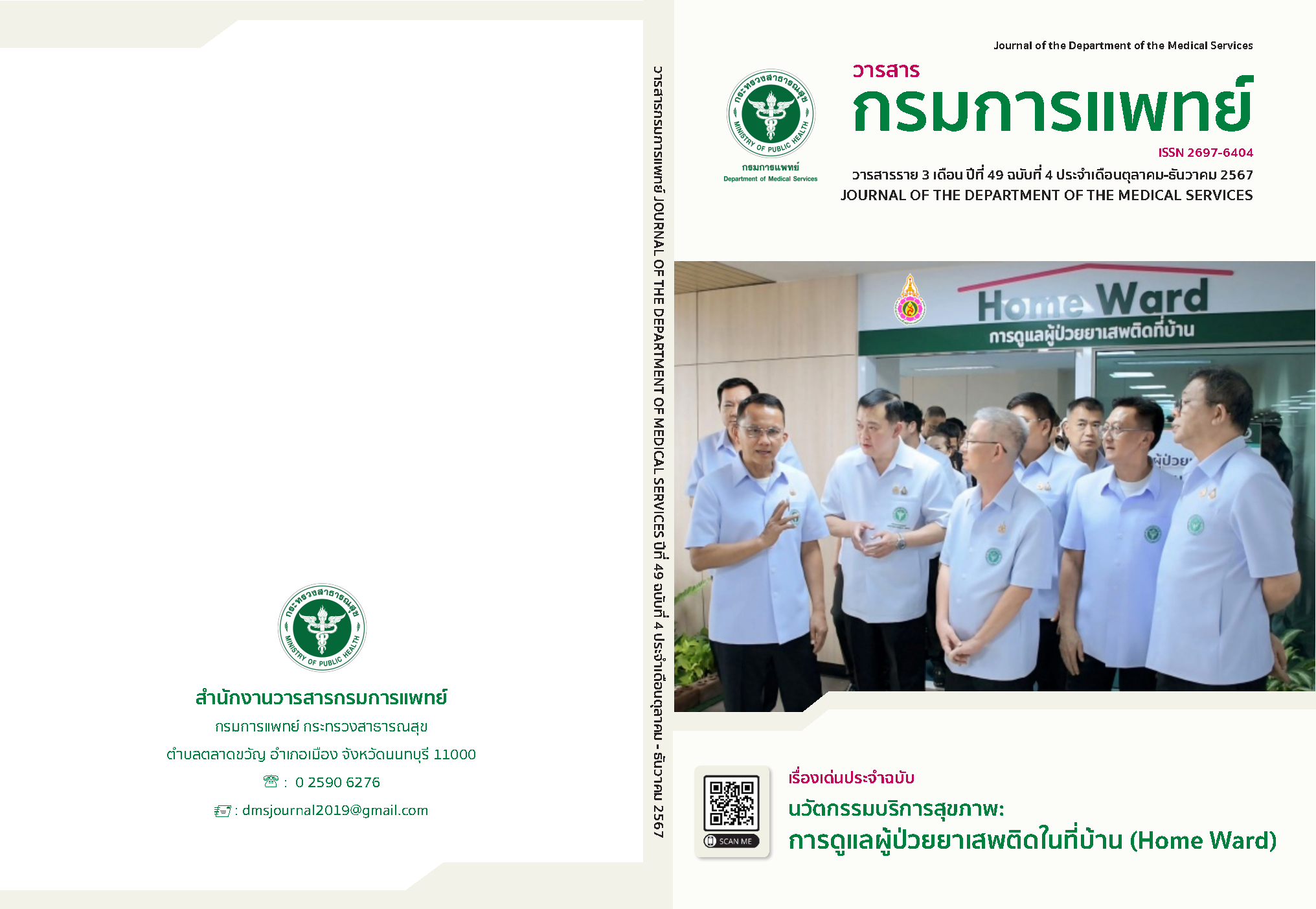การพัฒนาวิธีการตรวจยีน HLA-B*15:02 ด้วยเทคนิค Real-time PCR ในผู้ป่วยสถาบันประสาทวิทยา ที่ได้รับยา Carbamazepine เพื่อหลีกเลี่ยงการเกิดผื่นแพ้ยาชนิดกลุ่มอาการ Steven-Johnson Syndrome (SJS) และ Toxic Epidermal Necrolysis (TEN)
คำสำคัญ:
HLA-B*15:02, เรียลไทม์พีซีอาร์, กลุ่มอาการสตีเวนจอห์นสัน, กลุ่มอาการ toxic epidermal necrolysis (TEN), คาร์บามาซีพีนบทคัดย่อ
ภูมิหลัง: กลุ่มอาการสตีเวนจอห์นสัน (Steven-Johnson syndrome; SJS) และกลุ่มอาการ toxic epidermal necrolysis (TEN) คืออาการแพ้ยาหรืออาการไม่พึงประสงค์จากการใช้ยาที่รุนแรงและอาจทำให้ผู้ที่แพ้ยามีโอกาสพิการหรือเสียชีวิตมากถึงร้อยละ 30 ผู้ที่มีอาการแพ้ยาส่วนใหญ่จะเข้ารับการรักษาตัวที่โรงพยาบาลเป็นระยะเวลานาน มีค่าใช้จ่ายในการรักษาสูงและต้องรักษาต่อเนื่องหลังจากออกจากโรงพยาบาลเป็นเวลาหลายเดือน ส่งผลให้มีภาระด้านรายจ่ายจากการรักษาโรคที่เพิ่มขึ้น ดังนั้นการตรวจหายีน HLA-B*15:02 ก่อนการจ่ายยาสามารถช่วยแพทย์ในการเลือกยารักษาโรคเพื่อป้องกัน ADR หรือการแพ้ยาในผู้ป่วย วัตถุประสงค์: เพื่อพัฒนาเทคนิค Real-time PCR ในการตรวจหายีน HLA-B*1502 วิธีการ: เก็บตัวอย่างเลือดในหลอด EDTA 76 ตัวอย่างจากผู้ป่วยที่แพทย์สั่งให้ตรวจคัดกรองยีน HLA-B* 15:02 สกัดดีเอ็นเอและใช้ไพรเมอร์และโพรบที่ออกแบบเฉพาะสำหรับยีน HLA-B*15:02 จากฐานข้อมูล HLA เปรียบเทียบผลที่ได้กับวิธีการหาลำดับเบส Sanger gene sequencing เพื่อที่จะหาปฏิกิริยาที่เหมาะสำหรับการตรวจหายีน HLA-B* 15:02 ผล: ในการศึกษานี้วิธีการตรวจวิเคราะห์ที่พัฒนาขึ้นสามารถตรวจพบยีน HLA-B*15:02 จำนวน 29 ตัวอย่างจากทั้งหมด 76 ตัวอย่าง ในขณะที่ 47 ตัวอย่างให้ผลการตรวจเป็นลบ คิดเป็นร้อยละ 38.15 และ 61.85 ตามลำดับ เปรียบเทียบผลของตัวอย่าง 29 ตัวอย่างที่ให้ผลบวกกับ วิธี Sanger gene sequencing พบว่าให้ผลเหมือนกันกับวิธีการตรวจที่พัฒนาขึ้น โดยมีค่าความไวและความจำเพาะอยู่ที่ร้อยละ 100 สรุป: การศึกษานี้ประสบผลสำเร็จในการพัฒนาชุดตรวจ ยีน HLA-B*15:02 allele เพื่อป้องกันการเกิดผื่นแพ้ SJS/TEN ก่อนได้รับการรักษาด้วยยาคาร์บามาซีพีน
References
Tassaneeyakul W, Tiamkao S, Jantararoungtong T, Chen P, Lin SY, Chen WH, et al. Association between HLA-B*1502 and carbamazepine-induced severe cutaneous adverse drug reactions in a Thai population. Epilepsia 2010;51(5):926-30.
Harr T, French LE. Toxic epidermal necrolysis and Stevens-Johnson syndrome. Orphanet J Rare Dis 2010;5:39.
Locharernkul C, Shotelersuk V, Hirankarn N. Pharmacogenetic screening of carbamazepine-induced severe cutaneous allergic reactions. J Clin Neurosci 2011;18(10):1289-94.
Yang CY, Dao RL, Lee TJ, Lu CW, Yang CH, Hung SI, et al. Severe cutaneous adverse reactions to antiepileptic drugs in Asians. Neurology 2011;77(23):2025-33.
Locharernkul C, Loplumlert J, Limotai C, Korkij W, Desudchit T, Tongkobpetch S, et al. Carbamazepine and phenytoin induced Stevens-Johnson syndrome is associated with HLA-B*1502 allele in Thai population. Epilepsia 2008;49(12):2087-91.
Chen P, Lin JJ, Lu CS, Ong CT, Hsieh PF, Yang CC, et al. Carbamazepine-induced toxic effects and HLA-B*1502 screening in Taiwan. N Engl J Med 2011;364(12):1126-33.
Lim KS, Kwan P, Tan CT. Association of HLA-B*1502 allele and carbamazepine induced severe adverse cutaneous drug reaction among Asians, a review. Neurology Asia 2008;13:15-21.
Man CB, Kwan P, Baum L, Yu E, Lau KM, Cheng AS, et al. Association between HLAB*1502 allele and antiepileptic drug-induced cutaneous reactions in Han Chinese. Epilepsia 2007;48(5):1015-8.
Pavlos R, Mallal S, Phillips E. HLA and pharmacogenetics of drug hypersensitivity. Pharmacogenomics 2012;13(11):1285-306.
Wang Q, Zhou JQ, Zhou LM, Chen ZY, Fang ZY, Chen SD, et al. Association between HLA-B*1502 allele and carbamazepine-induced severe cutaneous adverse reactions in Han people of southern China mainland. Seizure 2011;20(6):446-8.
Virakul S, Kupatawintu P, Nakkuntod J, Kangwanshiratada O, Vilaivan T, Hirankarn N. A nested sequence-specific primer-polymerase chain reaction for the detection of HLA-B*15:02. Tissue Antigens 2012;79(4):295-301.
Sayer DC, Csssell HS, Christiansen FT. HLA-B*27 typing by sequence specific amplification without DNA extraction. Mol Pathol 1999;52(5):300-1.
Puangpetch A, Koomdee N, Chamnanphol M, Jantararoungtong T, Santon S, Prommas S, et al. HLA-B allele and haplotype diversity among Thai patients identified by PCR-SSOP: evidence for high risk of drug-induced hypersensitivity. Front Genet 2015;5(478):1-7.
Nguyen DV, Vidal C, Chu HC, Do NT, Tran TT, Le HT, et al. Validation of a novel real-time PCR assay for detection of HLA-B*15:02 allele for prevention of carbamazepine - Induced Stevens-Johnson syndrome/Toxic Epidermal Necrolysis in individuals of Asian ancestry. Hum Immunol 2016;77(12):1140-6.
Pegels N, Gonzalez I, Lopez-Calleja I, Fernandez S, Garcia T, Martin R. Evaluation of a TaqMan real-time PCR assay for detection of chicken, turkey, duck, and goose material in highly processed industrial feed samples. Poult Sci 2012;91(7):1709-19.
Prasertsang J, Vejbaesya S, Luangtrakool K, Chongkolwatana V. Development of in-house real-time polymerase chain reaction for HLA-B locus typing. J Hematol Transfus Med 2021;31:253-9.
Buchner A, Hu X, Aitchison KJ. Validation of single nucleotide variant assays for human leukocyte antigen haplotypes HLA-B*15:02 and HLA-A*31:01 across diverse ancestral backgrounds. Front Pharmacol 2021;12:713178.
Kulkantrakorn K, Tassaneeyakul W, Tiamkao S, Jantararoungtong T, Prabmechai N, Vannaprasaht S, et al. HLA-B*1502 strongly predicts carbamazepine-induced Stevens-Johnson syndrome and toxic epidermal necrolysis in Thai patients with neuropathic pain. Pain Pract 2012;12(3):202-8.
Downloads
เผยแพร่แล้ว
How to Cite
ฉบับ
บท
License
Copyright (c) 2024 กรมการแพทย์ กระทรวงสาธารณสุข

This work is licensed under a Creative Commons Attribution-NonCommercial-NoDerivatives 4.0 International License.
บทความที่ได้รับการตีพิมพ์เป็นลิขสิทธิ์ของกรมการแพทย์ กระทรวงสาธารณสุข
ข้อความและข้อคิดเห็นต่างๆ เป็นของผู้เขียนบทความ ไม่ใช่ความเห็นของกองบรรณาธิการหรือของวารสารกรมการแพทย์


